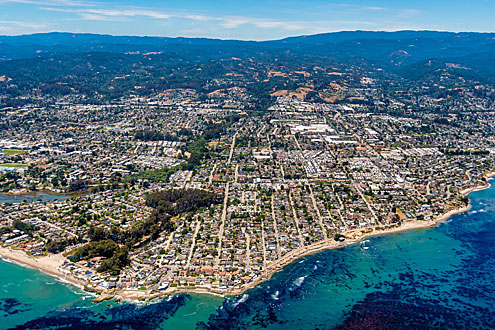As California faces the realities of climate change, its precious water resources are under increasing stress.
Understanding these shifting patterns is crucial as we work to develop sustainable water supply solutions.
Today’s climate models forecast more winter precipitation over the coming decades, but it will occur over shorter periods through intense storms, driven by increasingly frequent and powerful atmospheric rivers. These long, narrow corridors of concentrated moisture in the atmosphere can deliver enormous amounts of rain over short periods, often leading to substantial risk of both drought and flooding.
Current model projections suggest that while the overall intensity of atmospheric rivers will increase, their landfall is expected to shift further north of the central coast.
Instead of four to six major winter storms, the region is projected to experience fewer storms and also less consistent rain. The decrease in frequency, combined with the increased intensity, poses significant challenges for aquifer recharge.
Aquifer recharge relies on steady, sustained precipitation that percolates through the soil and ultimately replenishes the groundwater basin. However, with more intense and shorter-duration rain events, much of this precipitation will run off into rivers, streams, and ultimately the ocean, rather than being absorbed into the ground.
The expected shift in atmospheric river patterns and precipitation timing means that the aquifers, which historically benefited from more consistent winter rains, may receive less natural recharge.
For the District, which is 100% reliant on groundwater, this presents a major concern. However, the District has been proactive in managing its groundwater resources through innovative approaches and will start recharging the groundwater basin through the Pure Water Soquel project in 2025.
Atmospheric rivers play a key role in California’s water cycle, providing much of the state’s winter precipitation. These powerful storm systems originate over the Pacific Ocean and can carry vast amounts of water vapor, which condenses into rain or snow when they make landfall. In the past, the central coast region has benefited from these periodic events, but the future brings a different picture.
While more intense rainfall might seem like a positive development in addressing water shortages, the reality is more complicated. Losing much of that water to runoff — rather than contributing to groundwater recharge — is especially problematic for the central coast, where the majority of precipitation typically arrives in winter and contributes to the groundwater, which is relied upon during the dry summer months.
Moreover, as atmospheric rivers shift northward, regions like the Pacific Northwest are projected to receive more of this moisture, leaving the central coast with fewer opportunities for significant rainfall. This geographic shift in storm patterns could lead to longer dry spells and more reliance on engineered recharge projects, like Pure Water Soquel.
In response to these complex long-term challenges, Soquel Creek Water District has prioritized developing sustainable water solutions.
The District’s proactive approach to managing groundwater resources, particularly through water efficiency programs and projects like Pure Water Soquel, serves as a model for other regions facing similar climate-induced water supply challenges. By implementing potable reuse of purified recycled wastewater for groundwater replenishment, the District is working to ensure its aquifers remain viable even in the face of declining natural recharge.
With its Pure Water Soquel groundwater replenishment project, Soquel Creek Water District is working with regional partners to address the impacts that climate variability are already having on the water supply. Other water agencies — throughout California, the US, and the world — are also seeing the need to continue innovating and investing in sustainable water solutions.
The future may be uncertain, but with keen foresight, proactive planning, and the right strategies with adaptability, our region and others can protect and enhance water resources to create a secure, reliable water future.

